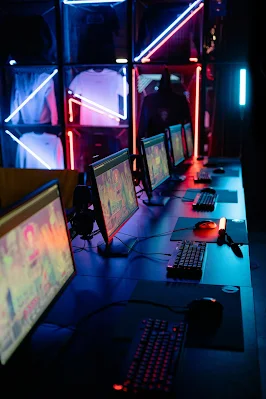Top 10 Settings to Make Your Laptop or Desktop Faster in 2025
In the fast-evolving world of computing, even powerful systems can slow down over time due to inefficient settings, bloated software, or outdated practices. Whether you're a student, a gamer, a content creator, or a professional, maximizing the performance of your laptop or desktop in 2025 can make a significant difference in productivity and experience.
Here are the top 10 settings and optimizations you should consider applying to your computer today to keep it running lightning fast.
1. Enable Hardware-Accelerated GPU Scheduling
Why it matters:
Modern CPUs and GPUs are designed to handle intensive tasks more efficiently when they work together. Hardware-accelerated GPU scheduling offloads high-priority tasks from the CPU to the GPU, improving frame rates and reducing latency.
How to enable it (Windows 10/11):
-
Go to Settings > System > Display.
-
Click Graphics Settings.
-
Toggle on Hardware-accelerated GPU scheduling.
-
Restart your system.
2. Adjust Power Settings to High Performance or Ultimate Performance
Why it matters:
Power-saving settings throttle CPU performance, which is not ideal when speed is the priority. Switching to a high-performance plan ensures your CPU runs at full capacity.
How to adjust:
-
Open Control Panel > Power Options.
-
Select High Performance or Ultimate Performance (available in Pro editions).
On laptops, remember this may reduce battery life, so use it when plugged in.
3. Disable Startup Programs
Why it matters:
Many programs sneak into your startup list, slowing down boot times and using memory unnecessarily.
How to disable:
-
Press Ctrl + Shift + Esc to open Task Manager.
-
Navigate to the Startup tab.
-
Right-click and disable programs you don’t need at startup.
4. Keep Your Operating System and Drivers Updated
Why it matters:
Updates often include performance enhancements and bug fixes. Updated GPU, chipset, and storage drivers can significantly improve system speed.
Best practices:
-
Use Windows Update regularly.
-
Visit manufacturer websites (Intel, AMD, NVIDIA) for the latest drivers.
-
For Mac users, check System Preferences > Software Update.
5. Uninstall Bloatware and Unused Apps
Why it matters:
Pre-installed apps or rarely used software can eat up system resources and storage space.
How to clean up:
-
On Windows: Go to Settings > Apps > Installed Apps.
-
Sort by size or installation date to find unnecessary programs.
-
Uninstall those you don't use.
Use tools like Revo Uninstaller for a deeper clean.
6. Enable Storage Sense and Disk Cleanup
Why it matters:
Junk files, temporary data, and old updates accumulate over time, slowing your system and consuming disk space.
Windows 11:
-
Go to Settings > System > Storage.
-
Enable Storage Sense to automatically delete temporary files.
-
Click Cleanup recommendations for a manual review.
Also, run Disk Cleanup monthly:
-
Search for “Disk Cleanup” and select your drive.
-
Clean system files and previous Windows installations if needed.
7. Turn Off Visual Effects and Animations
Why it matters:
Fancy animations can consume CPU/GPU resources. Turning them off can boost speed, especially on older hardware.
How to disable:
-
Search “Adjust the appearance and performance of Windows”.
-
Choose Adjust for best performance or manually uncheck effects like shadows, animations, and fades.
On macOS:
-
Navigate to System Preferences > Accessibility > Display.
-
Check Reduce motion and Reduce transparency.
8. Manage Virtual Memory (Paging File) Efficiently
Why it matters:
Virtual memory acts as extra RAM using your storage. If it's not set correctly, it can slow down your system.
Recommended settings:
-
Let Windows manage it automatically (best for most users).
-
For custom: Set the initial and maximum size to 1.5x and 3x your actual RAM.
How to change:
-
Go to System Properties > Advanced > Performance Settings > Advanced tab > Virtual Memory.
9. Upgrade and Optimize Startup Disk (Preferably SSD)
Why it matters:
The shift from HDD to SSD offers a dramatic speed improvement. If you’re still on a hard drive, an upgrade is essential in 2025.
SSD optimization tips:
-
Avoid defragmenting SSDs. Instead, run Optimize Drives.
-
Enable TRIM (usually on by default).
-
Ensure SATA mode is set to AHCI in BIOS for optimal SSD performance.
Bonus: Use NVMe SSDs for even faster read/write speeds.
10. Use Lightweight Security and Avoid Redundant Utilities
Why it matters:
Heavy antivirus software and redundant "optimizer" tools can actually slow down your system.
Tips:
-
Windows Defender (Microsoft Defender) is lightweight and sufficient for most users in 2025.
-
Avoid having multiple antivirus programs running at once.
-
Use trusted lightweight alternatives if needed, such as Bitdefender Free or Malwarebytes (on-demand scanning only).
Bonus Tips for Advanced Users:
A. Disable Background Apps (Windows 11)
Go to Settings > Apps > Installed Apps, click on an app, and select Advanced Options to disable background permissions.
B. Optimize Browser Settings
Browsers like Chrome or Edge can hog RAM. Reduce extensions, enable hardware acceleration, and use efficient browsers like Brave or Vivaldi.
C. BIOS/UEFI Updates
Check your motherboard manufacturer's website for updates, especially if your system supports newer CPUs or memory optimizations.
D. Overclocking (for enthusiasts)
If your CPU/GPU and cooling system allow, overclocking can boost performance—but it requires caution and proper knowledge.
Conclusion
Keeping your laptop or desktop running fast in 2025 is a blend of smart settings, regular maintenance, and mindful upgrades. These top 10 tips are applicable to both Windows and macOS systems (with platform-specific nuances) and can lead to a noticeably faster and more responsive computer.
Whether you’re gaming, editing video, or just trying to get work done more efficiently, tuning these settings will help you stay ahead of the curve. Make these adjustments today and experience the difference in speed and productivity.





